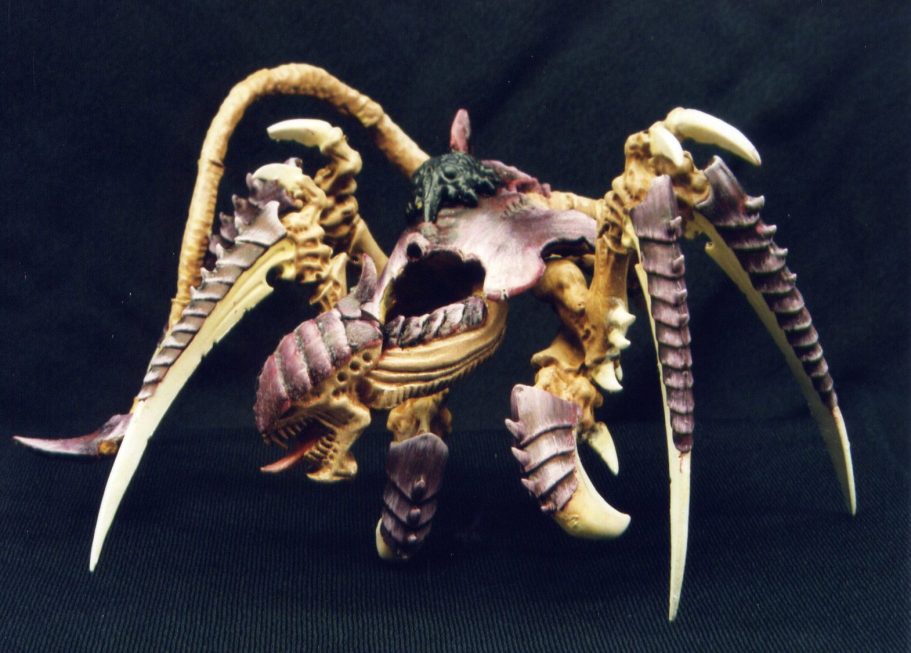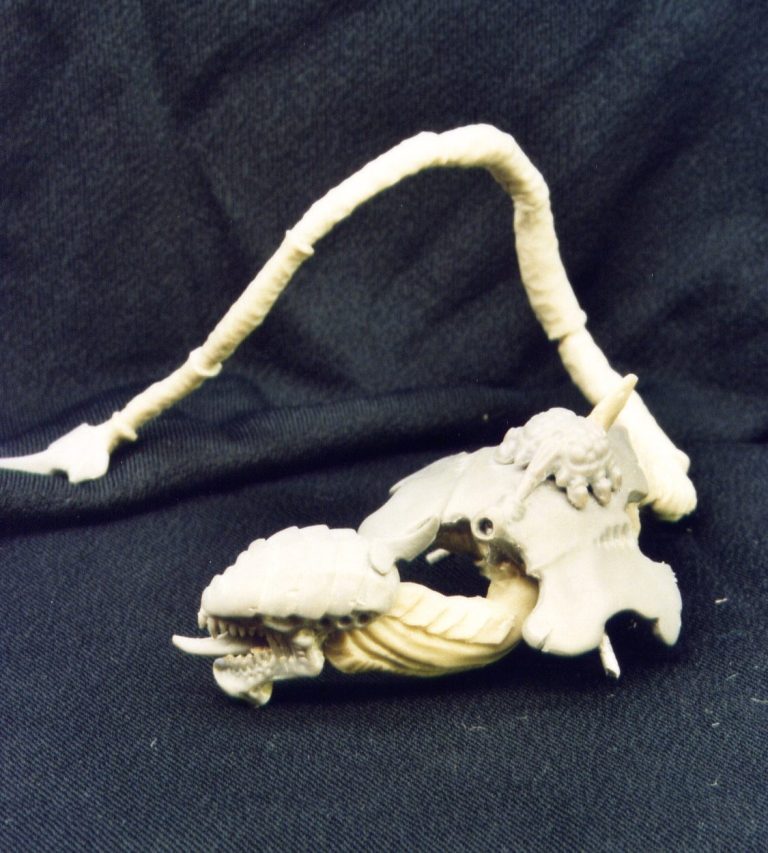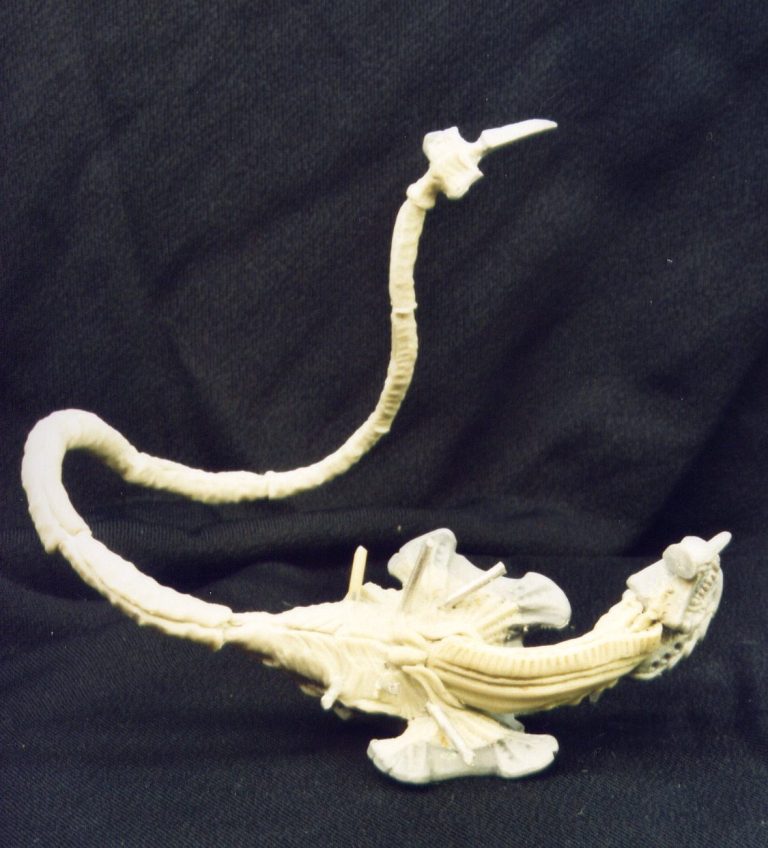
Tyranid Juvenile Heirophant
Assembled and painted by Thomas Hopwood in 2005 using spare plastic parts and Magic Sculpt putty

I suppose that I’d probably best tell you what a Tyranid is, just in case you didn’t know.
Games Workshop, many years ago, were searching for a race of creatures that could battle humans in their Warhammer 40,000 world of games.
Possibly inspired by Ridley Scott’s “Alien” that was designed by H. R. Geiger, GW staffers came up with Genestealers.
These had major differences of course to H.R. Gieger’s designs, but more than a few similarities too.
Anyway, as the race of Genestealers was developed, the Tyranids sprouted forth with more developed intellects and anatomies.

Genestealers now seem to have been almost relegated to the rank of cannon fodder in the games, as the Tyranids have been developed ( and still are being developed ) into nastier and more varied subspecies.
Tyranid variants, bearing in mind we’re working in 30mm scale here, can be from 20mm to over 400mm in height; and all that limits what you can have in your army, or in my case my painting display cabinet, is the size of your bank balance.
On a trip to the IPMS Telford show in 2004 I think, Thomas and I saw the very latest and largest addition to the Tyranid forces, a Tyranid Heirophant that was about 400mm tall. It’s bloody huge. So, for that matter is the price tag.

I’ll be honest though, if I could afford it, and a whole new cabinet for it to take the bottom shelf of, then I’d buy it – like yesterday !
But we’re in the real world here, and I’m just a poor, impoverished factory worker.
So the idea behind this model, is sort of like a young and ( when it theoretically grows up ) will be a better, meaner, and altogether uglier beastie than the GW one.
Thomas initially thought of building a Tyranid out of some spare parts from a large GW kit he’d bought. But as there was only the head and a back plate spare, plus a multitude of pincers, claws and hands, he was hitting a bit of a problem with how to join them together.

I came to the rescue, and said that I’d sculpt the missing bits, if he sort of gave me the design ideas ( O.K. I nudged him a little with some of the basics ), and he’s painted the finished model so that it could be entered as his in the junior classes at shows.
Please note, I’ll be admitting to having scratch built certain areas so the judges don’t get the wrong ideas.
Anyway, we started by adding a sausage of hardened Milliput to the back plate, gluing this in place, and then using further additions of putty to beef up the joint.
This gave a solid base to work on, although the sausage was intentionally too long, but would be cut down later. For now it was used as a handle, and six holes were drilled into it to accept wires that would hold the legs.
Thomas had selected four similar sized spikes that would be the legs and also two crablike claws. These were drilled so that they could slot onto the wires, and then tested for fit, bending the wires so that Thomas was happy with the positioning.
A seventh wire was added to take the head, this would have to have a neck sculpted onto it, but more of that later.
The legs were then removed so that Thomas could paint them separately, and I then busied myself with sculpting in the underside of the body. I used Magic Sculpt for this, and began at the front, under where the neck would be, and then worked around the sides.
With spare putty I also sculpted the neck, and then added this into the hole that we’d drilled, and sculpted some scapula around it. At this point I also removed the back end of the original sausage of Milliput, and drilled into the flat end to accept a long wire that would be the armature of the tail.
Thomas found a spiky bit to use at the tip of the tail, and working back from this towards the body, I added more Magic Sculpt to form a series of bone-like sections, gradually making each one overlap and slightly bigger in diameter to the previous one.


To make sure that the putty adhered to the wire, I added a smear of superglue to the metal, and then applied the Magic Sculpt.
Thomas meanwhile picked a colour scheme, and began painting the legs.
The initial coats of paint were acrylic, adding a primer of GW Skull White, thinned with some Isopropyl Alcohol. Several more coats were added, using a mix of the white with Orc Brown, thinning this with water. Once fully dry, Thomas added oil paints ( Mars Yellow, Titanium White and just a touch of Mars Brown ) to the model, and then gradually lightened the colour whilst still wet with more of the white. He used a basic dry-brushing method; final highlights being added with a much smaller brush.
For the larger scales Thomas used an undercoat of Imperial Purple, adding an oil coat over this with Purple Madder Alizarin, and used Titanium White to add the highlights.

He then used an old brush to apply some more of the white to add streaks to each scale, allowing the white to remain separate from the purple, rather than blending it in.
The colour scheme was continued over the whole model, and then fine details such as the eyes, tongue and teeth touched in with a fine brush.
Initially Thomas was just going to use the model as a wargames piece, but now I think he’s going to add a dead Space Marine and a bit of groundwork to it, and take it to shows.
Maybe the groundwork will be limited somewhat, so that after the shows, it can still be used as part of his army, who knows ?

As a sculpting project, it was interesting to work on, and quite fun, as I don’t often get to work in this scale anymore. Also it allowed “Lad and Dad” a bit of quality time modelling, rather than him trying to wheedle my models off the shelf so he can have a stab at making them.
I reckon to have been “away” from GW stuff in this scale for quite some time now – maybe ten years since I painted anything, but I do still buy models – for the 50 year plan – that I do fully intend making; honest !

The good thing about some of the larger plastic kits is the optional extras and spare bits that you get. This is also true of the plastic multi-packs of 15- 20 figures. There’s a whole wealth of extra bits for the spares box, and as in this case, a whole new figure can be built with spares, with just a small amount of ingenuity and model putty.
GW do some superb models, and I really would like to get back to painting one or two of the ones that I’ve bought.
Maybe sometime soon.
We need your consent to load the translations
We use a third-party service to translate the website content that may collect data about your activity. Please review the details in the privacy policy and accept the service to view the translations.